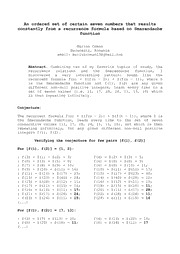
An ordered set of certain seven numbers that results constantly from a recurrence formula based on Smarandache function PDF
Preview An ordered set of certain seven numbers that results constantly from a recurrence formula based on Smarandache function
An ordered set of certain seven numbers that results constantly from a recurrence formula based on Smarandache function Marius Coman Bucuresti, Romania email: [email protected] Abstract. Combining two of my favorite topics of study, the recurrence relations and the Smarandache function, I discovered a very interesting pattern: seems like the recurrent formula f(n) = S(f(n – 2)) + S(f(n – 1)), where S is the Smarandache function and f(1), f(2) are any given different non-null positive integers, leads every time to a set of seven values (i.e. 11, 17, 28, 24, 11, 15, 16) which is then repeating infinitely. Conjecture: The recurrent formula f(n) = S(f(n – 2)) + S(f(n – 1)), where S is the Smarandache function, leads every time to the set of seven consecutive values {11, 17, 28, 24, 11, 15, 16}, set which is then repeating infinitely, for any given different non-null positive integers f(1), f(2). Verifying the conjecture for few pairs [f(1), f(2)] For [f(1), f(2)] = [1, 2]: : f(3) = S(1) + S(2) = 3; f(4) = S(2) + S(3) = 5; : f(5) = S(3) + S(5) = 8; f(6) = S(5) + S(8) = 9; : f(7) = S(8) + S(9) = 10; f(8) = S(9) + S(10) = 11; : f(9) = S(10) + S(11) = 16; f(10) = S(11) + S(10) = 17; : f(11) = S(16) + S(17) = 23; f(12) = S(17) + S(23) = 40; : f(13) = S(23) + S(40) = 28; f(14) = S(40) + S(28) = 12; : f(15) = S(28) + S(12) = 11; f(16) = S(12) + S(11) = 15; : f(17) = S(11) + S(15) = 16; f(18) = S(15) + S(16) = 11; : f(19) = S(16) + S(11) = 17; f(20) = S(11) + S(17) = 28; : f(21) = S(17) + S(28) = 24; f(22) = S(28) + S(24) = 11; : f(23) = S(24) + S(11) = 15; f(24) = S(11) + S(15) = 16 (...) For [f(1), f(2)] = [7, 13]: : f(3) = S(7) + S(13) = 20; f(4) = S(13) + S(20) = 18; : f(5) = S(20) + S(18) = 11; f(6) = S(18) + S(11) = 17 (...) For [f(1), f(2)] = [5, 11]: : f(3) = S(5) + S(11) = 16; f(4) = S(11) + S(16) = 17; (...) : f(12) = 11; f(13) = 17 (...) For [f(1), f(2)] = [531, 44]: : f(3) = S(531) + S(44) = 70; f(4) = S(44) + S(70) = 18; : f(5) = S(70) + S(18) = 13; f(6) = S(18) + S(13) = 19; : f(7) = S(13) + S(19) = 32; f(8) = S(19) + S(32) = 27; : f(9) = S(32) + S(27) = 17; f(10) = S(27) + S(17) = 26; : f(11) = S(17) + S(26) = 30; f(12) = S(26) + S(30) = 18; : f(13) = S(30) + S(18) = 11; f(14) = S(18) + S(19) = 17 (...) For [f(1), f(2)] = [341, 561]: : f(3) = S(341) + S(561) = 48; f(4) = S(561) + S(48) = 23; : f(5) = S(48) + S(23) = 29; f(6) = S(23) + S(29) = 52; : f(7) = S(29) + S(52) = 42; f(8) = S(52) + S(42) = 20; : f(9) = S(42) + S(20) = 12; f(10) = S(20) + S(12) = 9; : f(11) = S(12) + S(9) = 10; f(12) = S(9) + S(10) = 11; (...) : f(22) = 11; f(23) = 17 (...) For [f(1), f(2)] = [49, 121]: : f(3) = S(49) + S(121) = 35; f(4) = S(121) + S(35) = 29; : f(5) = S(35) + S(29) = 36; f(6) = S(29) + S(36) = 35; : f(7) = S(36) + S(35) = 13; f(8) = S(35) + S(13) = 20; : f(9) = S(13) + S(20) = 18; f(10) = S(20) + S(18) = 11; : f(11) = S(18) + S(11) = 17 (...) Open problems I. Is there any exception to this apparent rule? II. Is there a finite or infinite set of exceptions? III. Is there a superior limit for n such that eventually f(n) = 11 and f(n + 1) = 17? IV. Is the obtaining of a constant repeating set of values a characteristic of other recurrent formulas based similarly on the Smarandache function, having three or more terms? 2
